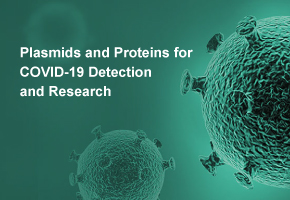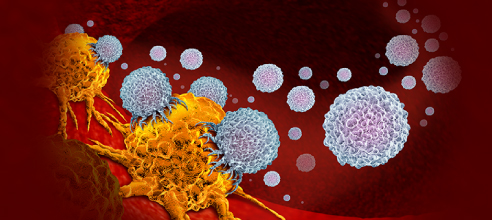Peptide Nucleic Acids
Peptide nucleic acids (PNAs) are synthetic nucleic acid analogs, which were first synthesized in 1991 by Peter E. Nielsen and colleagues. As shown in figure 1, unlike DNA and RNA, the phosphate sugar backbone of PNA is replaced by repeating N-(2-aminoethyl)-glycine units. Remarkably, PNAs are electrically neutral so that they generate no charge repulsion to DNA (or RNA) strands. Because of structural differences, PNAs show several attractive features including high thermal stability, resistance to enzymatic degradation, and strong binding to DNA or RNA and so on. In this article, we review the general features of PNAs and their applications.
Fig.1 Structure of peptide nucleic acid composed to DNA.(A) The PNA polypeptide backbone. (B)The sugar and phosphate backbone of normal DNA. B = nucleic acid base. The brackets with “n” indicate a polymer with multiple repeats (David P.Clark, et al.)
Significant Properties of PNAs
As
mentioned above, PNAs display strong binding affinity towards DNA and RNA, besides,
the unique properties of PNAs also including:
1. Thermal stability (Tm) of PNAs
The
thermal stability is measured by melting temperature. On average, the Tm of a PNA/DNA
duplex is 1℃ higher
per base pair compared to that of the corresponding DNA/DNA or DNA/RNA duplex.
Given the higher thermal stability and specificity of a PNA/DNA, the PNA can
able to block PCR in a sequence specific manner if targeted against one of the
PCR primer sites.
2. Stronger binding independent of
salt concentration
Because
of unnatural backbone of PNAs, the thermal stability of a PNA/DNA duplex is
bind independent of the salt concentration, whereas low ionic strength reduces
the stability of DNA/DNA duplexes. The Tm of a 15-mer PNAs decrease by only 5 ℃ as the
NaCl concentration is raised from 10 mM to 1M. Furthermore, at acidic pH (pH
4.5-6.5), PNAs show higher stability than DNA.
3. Resistance to enzymatic degradation
An
additional consequence of unnatural backbone of PNA is resistance to nucleases
and proteases-mediated degradation, extending the life time both in vitro and
in vivo.
4. Solubility of PNAs
PNAs
show low aqueous solubility, generally, the solubility of PNAs decreases as the
polymer length. To improve the solubility, some strategies have been developed
including terminal modification with charged amino acids such as L-lysine as
well as modification of aminoehlyglycyl backbone.
Synthesis and modifications of PNAs
The procedures of PNAs synthesis are similar to peptides, which usually synthesized via solid phase techniques, either by manual or automated. However, with the growth of PNAs chain, PNA has the tendency of aggregation, particularly of purine-rich sequences. Additionally, low coupling efficiency is also common problems in solid phase synthesis. With more than 15 years experiences in peptide services, GenScript has develop a strategy to overcome these problems, for example, a PNA Lys-AGCTAGCT-Gly is successfully delivered with high coupling efficiency and without aggregate.
Fig.2. HPLC (A) and MS (B) result in
GenScript. PNAs sequence: Lys-AGCTAGCT-Gly.
Want to have a PNA? Contact us at peptide@genscript.com
As stated above, despite the attractive features of PNAs make it as a potential candidate to develop therapeutic and diagnostic agents, there are basic challenges still remaining for such applications such as poor uptake by cells, low aqueous solubility. To solve these problems, many researcher are focusing on PNAs modifications (α-, β- and γ- position). For instance, hybridization properties are enhanced with γ- substituents. To enhance the cellular uptake of PNAs, current main methods are conjugate with cell penetrating peptides (CPPs), use of complementary DNA to mediate PNAs uptake or incorporate into liposomes, as shown in Fig.3.
Fig.3. Two methods for cellular delivery. (A) Transfection of PNAs. (B) CPP-PNA conjugate. (Saarbach et al.)
To improve solubility of PNAs, introduction of cationic functional groups is recommended because of good solubility of charged PNAs. Moreover, introduction of a G-clamp modified nucleobase, via both base pairing and base stacking enhanced the duplex stability while increasing the solubility because of the presence of positively charged side chains. Gupta with colleagues summarized a list of PNAs modifications in backbone and nucleobase modifications, find more in Table 1 and Table 2.
Table 1. Modifications in PNAs backbone along with the impact of modifications in properties. (A. Gupta et al.)
Table 2. Nucleobase modifications and their effects on PNAs backbone. (A. Gupta et al.)
Applications of PNAs Technology
Based
on the unique features, PNAs are widely applied in research laboratories, diagnostics,
gene editing, disease monitoring, etc.
Gene silencing: antigene and antisense
PNA-mediated gene silencing includes antigene and antisense activities. PNA is capable of binding mRNA and inhibit translation of the target gene. Application of PNAs as antisense reagents was first demonstrated in 1992, the nuclear microinjection of a 15-mer PNA targeting the translation start region of SV40 large T antigen mRNA inhibited transcription in cell extracts. That is to say, the antisense activity of PNAs is to block the translation of target gene by interfering the mRNA target sequences. By complementarily binding of PNAs to the target DNA, PNAs as antigene agents inhibit the transcription initiation or elongation of target gene. As stated above, the gene silencing activity of PNAs is a consequence of their ability to bind DNA or RNA. Several types of possible PNA::DNA or PNA::RNA complexes have been reported depending on sequence compositions (% of pyrimidine and purine bases), the number of PNA molecules binding to the target DNA/RNA sequence, and the structural features of PNAs (Fig.4).
Fig.4. Binding patterns and characteristics of the PNA-nucleic acid complexes. (Lee, et al)
PNAs mediated gene editing
Recently most popular gene editing technology is CRISPR technology because of facile reagent design. However, the CRISPR approach introduces an active nuclease into cells, which can lead to off-target cleavage in the genome. Unlike CRISPR technology, the ability of PNAs to induce recombination comes directly from their ability to tightly bind at their cognate sites, as they do not possess any direct nuclease activity. Triplex-forming peptide nucleic acids (PNAs) are designed to bind site-specifically to genomic DNA via strand invasion. Such invasion results in a modified helical structure that is recognized by the endogenous DNA repair machinery, and induces recombination with a donor DNA. Bahal, et al. found that the off-target rate of γtcPNA is as low as 0.00034 in vivo.
Fig.5 PNA mediated gene editing. (Saarbach et al.)
In situ hybridization (PNAs-FISH)
PNAs
probe can substitute to a set of longer DNA probe and bind to DNA or RNA under
low ionic strength conditions. Additional benefits are lower background
signals, mild washing procedure and unlimited stability of the probe mixture. PNA
probes are compatible with a wide range of reporter molecules and fluorochromes
including fluoresceine, rhodamine as well as cyanine and Alex dyes available in
a large variety of colors. PNAs-FISH can be used in the diagnosis of bacterial
vaginosis, which is time saving and highly specific. In another study, PNAs probe
FISH assay was used for detecting mycobacteria with great specificity and
sensitivity which helps in the fast and effective treatment of tuberculosis.
Additionally, PNA also can be used in PCR to detect single base-pair gene variants for mutation screening and gene isolation. Due to specific interactions with DNA/RNA and stability make PNAs promising in wide applications, much attention has recently been given for possible clinical applications of PNAs, such as anti-infective, cancer therapy (Table 3). This article is just the tip of the iceberg, with more and more medical and biotechnical applications being reported, PNAs will be a promising tool for the future.
Table 3. PNA applications in molecular
biology and medical fields (Lee, et al)
For
any queries, please contact us at peptide@genscript.com or leave a comment
Special offer:
From
now through 8/31/2020, get up to $900 reduction on your gene synthesis and
peptide online orders. Click here to learn more.
Next issue: Cyclic Peptides
Recommended Reading:
1.
Peptide
Conjugation: KLH, BSA and OVA
2.
Fluorescent
Modifications for Peptides
3.
What
you need to know about peptide modifications - Fatty Acid Conjugation
References
1. Pellestor, Franck, and Petra
Paulasova. "The peptide nucleic acids (PNAs), powerful tools for molecular
genetics and cytogenetics." European journal of human genetics 12.9
(2004): 694-700.
2. Siddiquee, Shafiquzzaman, Kobun
Rovina, and Asis Azriah. "A review of peptide nucleic acid." Advanced
Techniques in Biology & Medicine (2015): 1-10.
3. Lee, Hyung Tae, Se Kye Kim, and
Jang Won Yoon. "Antisense peptide nucleic acids as a potential
anti-infective agent." Journal of Microbiology 57.6 (2019): 423-430.
4. Nielsen, Peter E., ed. Peptide
nucleic acids: methods and protocols. No. 208. Springer Science & Business
Media, 2002.
5. David P.Clark, et al. Chapter 5 - Manipulation of Nucleic Acids (https://doi.org/10.1016/B978-0-12-813288-3.00005-7)
6. Ørum, Henrik, et al. "Single
base pair mutation analysis by PNA directed PCR clamping." Nucleic acids
research 21.23 (1993): 5332-5336.
7. Takiya, Toshiyuki, et al. "An
empirical approach for thermal stability (Tm) prediction of PNA/DNA
duplexes." Nucleic Acids Symposium Series. Vol. 48. No. 1. Oxford
University Press, 2004.
8. Gupta, Anjali, Anuradha Mishra, and
Nidhi Puri. "Peptide nucleic acids: Advanced tools for biomedical
applications." Journal of biotechnology 259 (2017): 148-159.
9. Bahal, Raman, et al. "In vivo
correction of anaemia in β-thalassemic mice by γPNA-mediated gene editing with
nanoparticle delivery." Nature communications 7.1 (2016): 1-14.
10. Saarbach, Jacques, Pramod M.
Sabale, and Nicolas Winssinger. "Peptide nucleic acid (PNA) and its
applications in chemical biology, diagnostics, and therapeutics." Current
opinion in chemical biology 52 (2019): 112-124.
11. Montazersaheb, Soheila, Mohammad
Saeid Hejazi, and Hojjatollah Nozad Charoudeh. "Potential of peptide
nucleic acids in future therapeutic applications." Advanced pharmaceutical
bulletin 8.4 (2018): 551.
12. Tailhades, Julien, et al.
"Solid-phase synthesis of difficult purine-rich PNAs through selective Hmb
incorporation: Application to the total synthesis of cell penetrating
peptide-PNAs." Frontiers in chemistry 5 (2017): 81.
13. Ricciardi, Adele S., et al. "Peptide nucleic acids as a tool for site-specific gene editing." Molecules 23.3 (2018): 632.
- Like (2)
- Reply
-
Share
About Us · User Accounts and Benefits · Privacy Policy · Management Center · FAQs
© 2025 MolecularCloud



